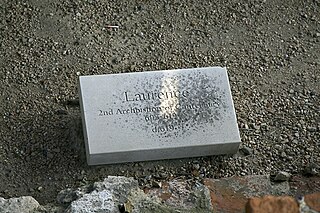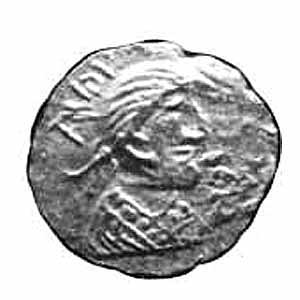External links
| Christian titles | ||
|---|---|---|
| Preceded by Beorhtred | Bishop of Lindsey 862x866 – 866x869 | Succeeded by Burgheard or Eadberht |
| This article about an English bishop or archbishop is a stub. You can help Wikipedia by expanding it. |
| Eadbald | |
|---|---|
| Bishop of Lindsey | |
| See | Diocese of Lindsey |
| In office | c.862/866 – c.866/869 |
| Predecessor | Beorhtred |
| Successor | Burgheard or Eadberht |
| Personal details | |
| Died | between 866 and 869 |
| Denomination | Christian |
Eadbald was a medieval Bishop of Lindsey.
Eadbald was consecrated between 862 and 866. He died between 866 and 869. His successor is uncertain, who could be either Burgheard or Eadberht. [1]
Burgheard was a medieval Bishop of Lindsey.
Eadberht was a medieval Bishop of Lichfield.
| Christian titles | ||
|---|---|---|
| Preceded by Beorhtred | Bishop of Lindsey 862x866 – 866x869 | Succeeded by Burgheard or Eadberht |
| This article about an English bishop or archbishop is a stub. You can help Wikipedia by expanding it. |
Æthelberht was King of Kent from about 589 until his death. The eighth-century monk Bede, in his Ecclesiastical History of the English People, lists him as the third king to hold imperium over other Anglo-Saxon kingdoms. In the late ninth century Anglo-Saxon Chronicle, he is referred to as a bretwalda, or "Britain-ruler". He was the first English king to convert to Christianity.

Justus was the fourth Archbishop of Canterbury. He was sent from Italy to England by Pope Gregory the Great, on a mission to Christianize the Anglo-Saxons from their native paganism, probably arriving with the second group of missionaries despatched in 601. Justus became the first Bishop of Rochester in 604, and attended a church council in Paris in 614.

Laurence was the second Archbishop of Canterbury from about 604 to 619. He was a member of the Gregorian mission sent from Italy to England to Christianise the Anglo-Saxons from their native Anglo-Saxon paganism, although the date of his arrival is disputed. He was consecrated archbishop by his predecessor, Augustine of Canterbury, during Augustine's lifetime, to ensure continuity in the office. While archbishop, he attempted unsuccessfully to resolve differences with the native British bishops by corresponding with them about points of dispute. Laurence faced a crisis following the death of King Æthelberht of Kent, when the king's successor abandoned Christianity; he eventually reconverted. Laurence was revered as a saint after his death in 619.
Paulinus was a Roman missionary and the first Bishop of York. A member of the Gregorian mission sent in 601 by Pope Gregory I to Christianize the Anglo-Saxons from their native Anglo-Saxon paganism, Paulinus arrived in England by 604 with the second missionary group. Little is known of Paulinus' activities in the following two decades.

Eadbald was King of Kent from 616 until his death in 640. He was the son of King Æthelberht and his wife Bertha, a daughter of the Merovingian king Charibert. Æthelberht made Kent the dominant force in England during his reign and became the first Anglo-Saxon king to convert to Christianity from Anglo-Saxon paganism. Eadbald's accession was a significant setback for the growth of the church, since he retained his people's paganism and did not convert to Christianity for at least a year, and perhaps for as much as eight years. He was ultimately converted by either Laurentius or Justus, and separated from his first wife, who had been his stepmother, at the insistence of the church. Eadbald's second wife was Emma, who may have been a Frankish princess. She bore him two sons, Eormenred and Eorcenberht, and a daughter, Eanswith.
Eorcenberht of Kent was king of the Anglo-Saxon kingdom of Kent from 640 until his death, succeeding his father Eadbald.
Eadbald is an Anglo-Saxon male name, from the Old English words for rich and bold. It might refer to:

Abū ʿAbd Allāh Muḥammad ibn Jaʿfar, better known by his regnal title al-Muʿtazz bi-ʾllāh was the Abbasid caliph from 866 to 869, during a period of extreme internal instability within the Abbasid Caliphate, known as the "Anarchy at Samarra".
Æthelburh of Kent (born 601, sometimes spelled Æthelburg, Ethelburga, Æthelburga; Old English: Æþelburh, Æðelburh, Æðilburh, also known as Tate or Tata), was an early Anglo-Saxon queen consort of Northumbria, the second wife of King Edwin. As she was a Christian from Kent, their marriage triggered the initial phase of the conversion of the pagan north of England to Christianity.
Cuthwulf was a medieval Bishop of Hereford. He was consecrated between 836 and 839 and died between 857 and 866.
Mucel was a medieval Bishop of Hereford. He was consecrated between 857 and 866 and died between those same dates.
Deorlaf was a medieval Bishop of Hereford. He was consecrated between 857 and 866 and died between 884 and 888.

Ceolwulf was a medieval Bishop of Lindsey.
Beorhtred was a medieval Bishop of Lindsey.

Eadbald was a medieval Bishop of London.
Wulfsige was a medieval Bishop of Lichfield.
The Christianisation of Anglo-Saxon England was a process spanning the 7th century. It was essentially the result of the Gregorian mission of 597, which was joined by the efforts of the Hiberno-Scottish mission from the 630s. From the 8th century, the Anglo-Saxon mission was, in turn, instrumental in the conversion of the population of the Frankish Empire.
Emma was a member of the Austrasian royal family. She is sometimes identified with the Emma who married Eadbald of Kent.